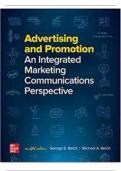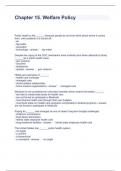,SOLUTION MANUAL FOR ADVERTISING AND PROMOTION AN
INTEGRATED MARKETING COMMUNICATIONS PERSPECTIVE
12TH EDITION BY GEORGE BELCH, MICHAEL BELCH
Chapter 1-22
CHAPTER 1
AN INTRODUCTION TO INTEGRATED MARKETING COMMUNICATIONS
Learning Objectives
1. Describe the role of advertising and other promotional elements in marketing.
2. Discuss the evolution of the integrated marketing communications (IMC) concept.
3. Explain the increasing value of the IMC perspective in advertising and promotional programs.
4. Identify the elements of the promotional mix.
5. Identify the contact points between marketers and their target audiences.
6. Describe the steps in the IMC planning process.
Chapter and Lecture Outline
I. INTRODUCTION TO ADVERTISING AND PROMOTION
The chapter begins with a brief discussion of the changing roles of advertising and promotional strategy
in modern marketing. Specifically, it offers a case study from Nike about their willingness to take a risk
and utilize Colin Kaepernick in their anniversary campaign. The case shows that Nike was willing to
change their marketing strategy in order to adapt to the new ways in which companies and brands
communicate with consumers. Instructors should discuss how increases in audience fragmentation and a
shift to digital media have spearheaded this change in brand/consumer communication. Consumers no
longer just passively receive messages, but serve as content creators as well. Brands must be willing to
adapt their strategies, moving away from solely an advertising focus to a holistic approach that attempts
to engage consumers in a conversation: an IMC approach. Instructors should also stress the difference
between IMC, advertising, and public relations.
II. THE GROWTH OF ADVERTISING AND PROMOTION
Advertising and promotion are integral parts of our social and economic systems. Advertising has evolved
into a vital communication system for both consumers and businesses. In market-based economies,
consumers rely on advertising and other forms of promotion to provide them with information they can
use in making purchase decisions. Corporations rely on advertising and promotion to help them market
their products and services.
Evidence of the increasing importance of advertising and promotion in the marketing process comes from
the growth in expenditures in these areas over the past decade. In 1980, advertising expenditures in the
U.S. were $53 billion and $49 billion was spent on sale promotion. In 2019, $240 billion was spent on
1-1
Copyright © 2021 McGraw-Hill Education. All rights reserved.
No reproduction or distribution without the prior written consent of McGraw-Hill Education.
,advertising. Of that, $110 billion was spent on traditional advertising media such as TV, radio,
magazines, newspaper, and OOH. Digital/online advertising accounted for the other $130 billion. Billions
more are spent by both domestic and foreign companies in other promotional areas such as direct
marketing, event sponsorship, interactive marketing, sponsorships, consumer and trade promotions, and
public relations efforts. The tremendous growth in expenditures for advertising and promotion reflect the
growth of the U.S. and global economies. Expansion-minded marketers are taking advantage of growth
opportunities in various regions of the world and taking advantage of integrated marketing opportunities
through methods such as event sponsorship and the use of the Internet. Particularly noteworthy is the
increase in the amount of marketing communications dollars being spent online. For the first time ever, in
2019, digital ad dollars in the U.S. surpassed those dollars spent on traditional advertising media.
Specifically, 54 percent of advertising dollars in the U.S. went to digital advertising efforts while 46
percent went to traditional advertising media. By 2023, it is expected that digital advertising will account
for more than two-thirds of all advertising spending. These upward trends in ad spending, and particularly
digital ad spending, are seen globally, although U.S. advertising spending accounts for nearly a third of
the world‘s advertising expenditures.
Professor Notes:
III. THE ROLE OF MARKETING
Many students may already have had a marketing course; however, it is still helpful to define marketing
and stress that it involves more than just selling or other promotion functions. For more than two decades,
the American Marketing Association, the association that represents marketing professionals in the
United States and Canada, defined marketing as:
the process of planning and executing the conception, pricing, promotion, and distribution of
ideas, goods, and services to create exchanges that satisfy individual and organizational
objectives.
This definition of marketing focused on exchange as a central concept in the various activities involved in
the marketing process. Many experts argue that exchange is the core phenomenon or domain for study in
marketing. The discussion can focus on the nature of exchange and what is needed for this process to
occur including: two or more parties with something of value to one another; a desire and ability to give
up their something of value to the other party; and a way for the parties to communicate with one another.
In 2007, the AMA adopted a revised definition of marketing:
Marketing is the activity, set of institutions, and processes for creating, communicating, and
delivering exchange offerings that have value for customers, clients, partners and society at
large.
This definition of marketing is more reflective of the role of non-marketers to the marketing process. It
also focuses on the important role marketing plays in developing and sustaining relationships with
customers and delivering value to them.
Value is the customer‘s perception of all of the benefits of a product or service weighed against all the
costs of acquiring and using it. Benefits can be functional (focusing on the performance of the product),
experiential (focusing on what it feels like to use the product), or psychological (feelings that result from
1-2
Copyright © 2021 McGraw-Hill Education. All rights reserved.
No reproduction or distribution without the prior written consent of McGraw-Hill Education.
, owning a particular brand). Costs include the money paid for the product or service as well as other
factors such as acquiring information, making the purchase, learning how to use a product/service,
maintaining the product, and disposing of it.
A. The Marketing Mix—The four elements of the marketing mix (product, price, place, and
promotion) can be introduced and the task of combining these elements into an effective
marketing program for facilitating exchange with a target audience should be noted. The
instructor should point out that while this course focuses on the promotion element of the
marketing mix, the promotional program must be part of a viable marketing strategy and
coordinated with other marketing mix variables. This leads into a discussion of the concept of
integrated marketing communications.
Professor Notes:
IV. INTEGRATED MARKETING COMMUNICATIONS
A. The Evolution of IMC—In the past, many marketers built strong barriers around the various
marketing and promotional functions, planning and managing them separately with different
budgets, different views of the market and different goals and objectives. In the 1980s, however,
many companies began moving toward the concept of integrated marketing communications
(IMC), which involves coordinating the various promotional elements along with other marketing
activities that communicate with a firm‘s customers. As marketers embraced the concept of IMC,
they began asking their ad agencies to coordinate the use of a variety of promotional tools rather
than relying primarily upon media advertising. A number of companies began looking beyond
traditional advertising agencies, using other types of promotional specialists to develop and
implement various components of their promotional plans. As the advertising industry recognized
that IMC was more than just a fad, terms such as new advertising, orchestration, and seamless
communication were used to describe the concept of integration. A task force from the American
Association of Advertising Agencies (4As) developed one of the first definitions of integrated
marketing communications (MC) defining it as:
a concept of marketing communications planning that recognizes the added value of a
comprehensive plan that evaluates the strategic roles of a variety of communication
disciplines—for example, general advertising, direct response, sales promotion, and
public relations- and combines these disciplines to provide clarity, consistency, and
maximum communications impact.
Integrated marketing communications calls for a ―big picture‖ approach to planning marketing
and promotion programs and coordinating various communication functions. With an integrated
approach, all of a company‘s marketing and promotional activities should project a consistent and
unified image to the marketplace. However, advocates of IMC have argued for an even broader
perspective that considers all sources of brand or company contact that a customer or prospect
has with a company, product, or service.
An example of this unified communication approach is provided of Montblanc, a luxury leather
goods, tech, watch, and other accessory brand. The brand recognized that each interaction
consumers have with their brand serves as an opportunity for the brand to deliver on their brand
promise of quality products, to strengthen relationships with their customers, and deepen loyalty.
1-3
Copyright © 2021 McGraw-Hill Education. All rights reserved.
No reproduction or distribution without the prior written consent of McGraw-Hill Education.






